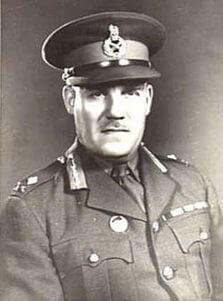Home » Creswick » History » People » Sir John Northcott
Sir John Northcott
 NORTHCOTT, Sir JOHN (1890-1966), army officer and Governor, was born on 24 March 1890 at Creswick, Victoria, eldest son of English-born parents John Northcott, storekeeper, and his wife Elizabeth Jane, née Reynolds. His father owned a store in the nearby town of Dean. Young John was educated at Dean State School and Grenville College, Ballarat. An enthusiastic former member of the school cadets, he was commissioned in August 1908 in a Militia unit, the 9th Light Horse Regiment (redesignated the 19th Light Horse in 1912). On 16 November 1912 he joined the Permanent Military Forces as lieutenant, Administrative and Instructional Staff, and was posted to the 6th Military District (Tasmania). He transferred to the Australian Imperial Force in August 1914 and was appointed adjutant of the 12th Battalion which was based at Anglesea Barracks, Hobart.
NORTHCOTT, Sir JOHN (1890-1966), army officer and Governor, was born on 24 March 1890 at Creswick, Victoria, eldest son of English-born parents John Northcott, storekeeper, and his wife Elizabeth Jane, née Reynolds. His father owned a store in the nearby town of Dean. Young John was educated at Dean State School and Grenville College, Ballarat. An enthusiastic former member of the school cadets, he was commissioned in August 1908 in a Militia unit, the 9th Light Horse Regiment (redesignated the 19th Light Horse in 1912). On 16 November 1912 he joined the Permanent Military Forces as lieutenant, Administrative and Instructional Staff, and was posted to the 6th Military District (Tasmania). He transferred to the Australian Imperial Force in August 1914 and was appointed adjutant of the 12th Battalion which was based at Anglesea Barracks, Hobart.
In October Captain Northcott sailed with his battalion for Egypt. On the morning of 25 April 1915 the 12th landed at Ari Burnu (Anzac Cove), Gallipoli. Almost immediately, Northcott was wounded in the chest by a rifle bullet. He was evacuated to Alexandria, Egypt, and thence to England, and took no further part in the war. On 14 September 1915 at the parish church, Oxted, Surrey, he married Winifred Mary Paton (d.1960), who had travelled to England to join him. His recuperation was prolonged, and he did not return to Australia until 30 December.
Like others in the permanent forces, Northcott had to accept a drop in rank when his A.I.F. appointment terminated on 30 September 1916. Nevertheless, he steadily advanced in his chosen career. He undertook several staff postings in Western Australia before attending the Staff College, Camberley, England, in 1924-25. Back in Australia, he served as staff officer (later director), stores and transport, at Army Headquarters, Melbourne. From 1933 he spent a longer period in England, during which he attended the Imperial Defence College, London, and the Senior Officers' School, Sheerness, and completed an attachment to the Committee of Imperial Defence.
In 1937 Northcott returned to Melbourne. His broad experience in staff appointments gave him an unrivalled knowledge of some areas, particularly transport, important to a future mobilization for war. His assiduity in making contact with people in industry, including influential figures like Essington Lewis, made him as well known outside the army as in it. At the outbreak of World War II he was director of military operations and intelligence, with the rank of brevet colonel. In October 1939 he was promoted local major general and appointed deputy-chief of the General Staff. He accompanied R. G. (Baron) Casey to the dominions' conference (October-December) in London as his military adviser.
Northcott was one of the regular officers who aspired to field command. In August 1940 the chief of the General Staff, General Sir Brudenell White, died in an air crash. Lieutenant General (Sir) Vernon Sturdee succeeded him. The post of commander, 8th Division, thus became available, but Northcott was excluded from consideration because his knowledge was vital to the new C.G.S. When Major General H. D. Wynter fell ill and Lieutenant General Sir Thomas Blamey asked in January 1941 for Northcott to command the 9th Division in the Middle East, Northcott was involved in organizing the 1st Armoured Division and the appointment went instead to Brigadier (Sir) Leslie Morshead. Northcott had to settle for command in Australia of the 1st Armoured Division (September 1941 to April 1942) and II Corps (April-September). He was promoted temporary lieutenant general in April 1942 (substantive 1 September).
On 10 September 1942 Northcott was appointed chief of the General Staff. As Blamey's principal non-operational subordinate, he was responsible for administering and training the army. Not only did he discharge his duties to Blamey's satisfaction, he also developed excellent relations with key officers at General Douglas MacArthur's headquarters, and worked harmoniously with members of the Royal Australian Navy and the Royal Australian Air Force. At the end of the war Sturdee was again invited to become C.G.S. He made it a condition of his acceptance that Northcott be given the appointment of commander-in-chief of the British Commonwealth Occupation Force in Japan, an indication of the genuine esteem in which Northcott's service was held. He headed B.C.O.F. from December 1945 to June 1946.
Throughout his army career Northcott was highly regarded as an outstanding staff officer. In contrast, his short periods in command of the 1st Armoured Division, II Corps and B.C.O.F. were noted neither for innovation nor conspicuous success. In two of these three appointments he was followed by (Sir) Horace Robertson who possessed the ebullience and flair that Northcott lacked. Northcott's qualities of correctness, competence and dedication were perhaps best displayed in his role as the first Australian-born and one of the longest-serving governors of New South Wales. Sworn in on 1 August 1946, he gave patronage and support to charitable organizations and to youth, church and citizens' groups. A staunch advocate of the British Empire, he was a widely known and respected figure throughout the State. He retired in July 1957.
Northcott had been appointed M.V.O. in 1927 for his service during the visit of the Duke and Duchess of York that year. He was appointed C.B. (1941), K.C.M.G. (1950) and K.C.V.O. (1954). In 1951 and 1956 he administered the Commonwealth of Australia; while occupying that office he held the honorary rank of General. He was awarded honorary degrees by the University of Sydney (D.Litt., 1952), the New South Wales University of Technology (D.Sc., 1956) and the University of New England (D.Litt., 1956). During his term as Governor he was Honorary Colonel of the 1st-15th Royal New South Wales Lancers. Survived by his two daughters, Sir John died on 4 August 1966 in his home at Wahroonga, Sydney; he was accorded a state funeral with military honours and was cremated with Presbyterian forms.

Business & Tourism Creswick Inc.
PO Box 214
Creswick, Victoria, 3363
info@creswick.net




